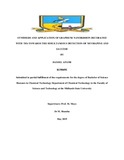Please use this identifier to cite or link to this item:
https://cris.library.msu.ac.zw//handle/11408/3727| Title: | Synthesis and application of graphene nanoribbon decorated with tio2 towards the simultaneous detection of nevirapine and glucose | Authors: | Apath, Daniel, A. A. | Keywords: | Graphene nanoribbons | Issue Date: | 2019 | Publisher: | Midlands State University | Abstract: | Graphene nanoribbons (GNRs), titanium dioxide (TiO2), and their composites Graphene nanoribbons/titanium dioxide (GNRs/TiO2) were employed towards the simultaneous detection of nevirapine (NVP) and glucose (GLC). The nanomaterials were characterized Fourier-transform infrared spectroscopy (FTIR), UV-vis and thermogravimetric analysis (TGA), cyclic voltammetry, electrochemical impedance spectroscopy, linear sweep voltammetry, differential pulse voltammetry, and chronoamperometry were utilized in the electrochemical detection of nevirapine and glucose. The optimum pH for the electrocatalytic detection of nevirapine and glucose simultaneously were determined to be pH 11.0 The limits of detection and quantification were deduced to be 1.27 x 10-7 M for glucose and 1.282 x 10-7 M for nevirapine and limit of quantification were also deduced to be 3.882 x 10-7 M for glucose and 3.882 x 10-7 M for nevirapine respectively using differential pulse voltammetry. The rate constant of 1.655 x 101 M1s-1 and 1.42 x 101 M-1s-1 for nevirapine and glucose respectively. surface area of the electrode and the surface coverage were determined to be 2.7 ×101 M-1 s-1, 0.238 cm2 and 1.58 x 10-5 mol cm2 respectively. The adsorption equilibrium constant ß was determined to be 3.3 x 104 M-1 from the Langmuir adsorption kinetic model with a Gibbs free energy of 25.34 KJ mol-1. GNRs/TiO2GCE showed excellent electrooxidation of nevirapine and glucose and oxidation over potential were lowered. The higher surface coverages were observed which indicating that modifiers were lying flat on the electrode surface. The GNRs/TiO2-GCE gave catalytic rate constants The limits of detection observed for nevirapine and glucose were 9.66 × 10-7 and 7.2 × 10-7 M respectively. The adsorption equilibrium constants for nevirapine and glucose were found to be 1.05 x 105 M-1 and 5.56 x 105 M-1 respectively. Furthermore, the high Tafel slopes were observed which indicated that the adsorption of each analyte to the surface of the electrode. The Gibb’s free energy for nevirapine and glucose were also found to be -28.63 kJ mol-1 and -27.07kJ mol-1 respectively. Interference studies were done and the electrode displayed the ability to detect both nevirapine and glucose. The electrode displayed good reproducibility with lower oxidation potential at 0.8 V and high sensitivity towards nevirapine and glucose. The developed sensor exhibited an excellent noninterference property and good reproducibility towards the detection of nevirapine and Glucose. | URI: | http://hdl.handle.net/11408/3727 |
| Appears in Collections: | Bsc Chemical Technology Honours Degree |
Files in This Item:
| File | Description | Size | Format | |
|---|---|---|---|---|
| SYNTHESIS AND APPLICATION OF GRAPHENE NANORIBBON DECORATED WITH TiO2 TOWARDS THE SIMULTANEOUS DETECTION OF NEVIRAPINE AND GLUCOSE.pdf | Full Text | 3.27 MB | Adobe PDF |  View/Open |
Page view(s)
136
checked on Feb 26, 2025
Download(s)
76
checked on Feb 26, 2025
Google ScholarTM
Check
Items in MSUIR are protected by copyright, with all rights reserved, unless otherwise indicated.


